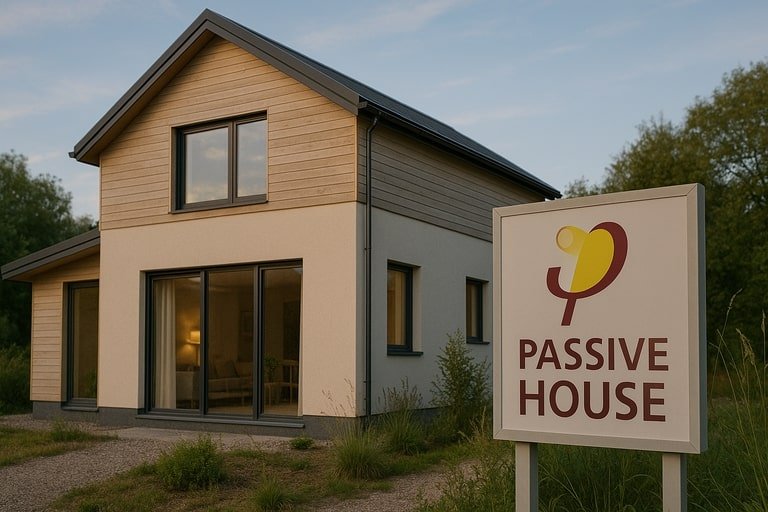Passive house design is transforming the construction landscape by redefining how energy, comfort, and sustainability intersect within the built environment. At its core, this approach prioritizes efficiency in heating, cooling, and ventilation, ensuring that homes and buildings consume minimal energy while maintaining exceptional indoor comfort. Unlike conventional methods that often depend heavily on mechanical systems, passive house design relies on architectural precision and sustainable construction strategies to achieve outstanding results. This shift is not simply about reducing consumption; it is about creating a new paradigm where buildings work in harmony with their environment.
The central principle of passive house design is reducing demand before adding supply. This is achieved by creating a highly insulated and airtight envelope that minimizes heat loss in winter and heat gain in summer. Advanced windows with multiple glazing layers and strategically placed shading systems help regulate temperature naturally. As a result, mechanical heating and cooling needs are drastically reduced, leading to energy savings and consistent indoor comfort. These design strategies prove that efficiency does not require compromise but rather thoughtful planning.
Sustainable construction practices are integral to passive house projects. Builders use responsibly sourced wood, recycled steel, and low-carbon concrete to ensure the environmental footprint of the structure remains minimal. By aligning material choices with ecological responsibility, passive house design becomes a full-cycle solution that begins long before occupancy. This focus on lifecycle sustainability sets it apart from traditional construction, where environmental considerations are often an afterthought.
Passive home architecture extends beyond efficiency to include comfort and health. Indoor air quality is maintained through balanced ventilation systems that provide continuous fresh air without energy loss. High-performance filters remove pollutants and allergens, creating environments where residents experience fewer health issues and greater wellbeing. Natural daylighting strategies further enhance psychological comfort, proving that sustainable design can also nurture human potential.
The role of energy-efficient buildings in urban contexts highlights the scalability of passive house principles. From single-family homes to multi-story apartment complexes and commercial spaces, passive strategies can be adapted to suit diverse contexts. This adaptability ensures that passive house design is not a niche approach but a universal framework for resilient construction. Cities adopting these standards benefit from lower emissions, improved infrastructure resilience, and healthier populations.
Economic considerations also drive adoption. While upfront costs may be higher than conventional builds, operational savings over time far outweigh the initial investment. Owners of passive house designs benefit from dramatically lower energy bills, increased property value, and eligibility for certifications and incentives. Developers, in turn, gain reputational advantages and meet rising consumer demand for sustainable housing. This financial logic underscores that ecological responsibility and profitability are not mutually exclusive.
Passive house design also demonstrates resilience in the face of climate change. By maintaining stable indoor temperatures regardless of external conditions, these structures provide security against extreme weather events. Residents enjoy uninterrupted comfort even during power outages or heatwaves, highlighting the protective qualities of energy-efficient buildings designed with foresight. This resilience is becoming increasingly critical as climate volatility intensifies.
On a societal level, the benefits of passive house design extend beyond individual owners. Widespread adoption reduces strain on national energy grids, lowers emissions, and supports national commitments to climate targets. These collective advantages transform passive house design from a private choice into a public good. Communities built around these principles represent a future where progress and responsibility coexist.
The cultural dimension of this design philosophy is equally powerful. As people experience the tangible benefits of energy efficiency and comfort, expectations for construction standards shift. Passive house design becomes the benchmark against which conventional buildings are judged, accelerating industry transformation. This shift demonstrates how consumer awareness and ecological responsibility drive systemic change.
Educational initiatives further amplify adoption. Universities, professional training centers, and certification bodies are preparing architects, engineers, and builders to apply passive house standards effectively. This knowledge transfer ensures that passive house design continues to evolve as technologies advance and societal needs change. The integration of education and practice ensures that the philosophy remains dynamic rather than static.
Ultimately, passive house design represents a profound rethinking of how humanity interacts with the built environment. By aligning sustainable construction, passive home architecture, and the broader goals of energy-efficient buildings, this approach offers a blueprint for resilient, comfortable, and environmentally responsible living. Its benefits extend across environmental, financial, and social domains, ensuring that passive house design will remain at the forefront of construction for decades to come.
Passive House Designs And Sustainable Architecture
Passive house designs represent the most refined intersection of sustainable architecture and human-centric living. Each project embodies meticulous planning, precise engineering, and an unwavering commitment to ecological responsibility. By emphasizing passive strategies such as insulation, airtightness, and ventilation, these designs go beyond aesthetics to deliver measurable performance outcomes. They illustrate how sustainable construction can achieve harmony between efficiency, comfort, and durability.
Architectural strategies in passive house designs focus on orientation, form, and material choice. Buildings are positioned to maximize solar gain in colder climates while incorporating shading devices to prevent overheating in warmer regions. Rooflines, wall thickness, and glazing ratios are all calculated with precision to balance energy flows. These considerations transform architecture into a science of efficiency while maintaining artistic expression.
Materials used in passive house designs reflect a conscious effort to reduce embodied carbon and environmental impact. From recycled insulation materials to sustainably harvested timber, choices are made with the full lifecycle of the building in mind. These practices ensure that sustainability begins at the construction site, reinforcing the philosophy that energy-efficient buildings must account for both operational and embodied emissions.
Ventilation plays a pivotal role in maintaining comfort and health in passive homes. Mechanical ventilation with heat recovery (MVHR) systems ensure continuous airflow while reclaiming thermal energy that would otherwise be wasted. The result is fresh, filtered air without significant heat loss, creating environments that are both healthy and efficient. These systems exemplify how advanced technologies integrate seamlessly with architectural principles.
Lighting strategies are equally critical. Passive house designs prioritize natural daylighting through large, south-facing windows and reflective surfaces. Artificial lighting is minimized, and when used, it is powered by highly efficient LED systems. This dual approach reduces energy consumption while enhancing wellbeing by connecting residents to natural light cycles.
Water conservation aligns naturally with passive strategies. Low-flow fixtures, rainwater harvesting, and greywater recycling ensure that efficiency extends beyond energy to include water use. These measures illustrate the holistic nature of passive house designs, where every resource is managed responsibly.
Economically, passive house designs appeal to a broad spectrum of stakeholders. Owners benefit from reduced energy bills and higher resale values, while developers gain market differentiation and compliance with evolving regulations. Incentives, certifications, and financing programs further support adoption, making sustainable architecture both financially viable and socially desirable.
Community benefits are amplified when passive house designs are scaled across neighborhoods. Collective reductions in energy demand ease pressure on public infrastructure while lowering urban emissions. These systemic advantages make passive strategies a foundation for resilient cities that thrive within ecological limits.
Cultural acceptance of passive house designs is steadily increasing. As residents experience the tangible benefits—comfort, savings, and health—the demand for sustainable architecture grows. This cultural shift ensures that passive principles move from niche to mainstream, reshaping construction norms globally.
Education and certification programs ensure quality and consistency in passive house design. Training architects, engineers, and builders in these standards guarantees that implementation is precise and outcomes are reliable. This professional development strengthens the credibility of the movement and ensures its growth into the future.
Ultimately, passive house designs represent a holistic approach to sustainable architecture. They embody a philosophy where buildings are not only efficient but also nurturing, resilient, and future-oriented. By merging technical precision with ecological responsibility, passive house designs provide a model for how construction can align human prosperity with planetary wellbeing.
Passive House Design And Benefits For People
The benefits of passive house design extend far beyond energy savings, encompassing health, comfort, economic stability, and environmental stewardship. These advantages demonstrate why passive strategies are rapidly gaining recognition as the gold standard for construction in an era defined by climate challenges and rising resource costs.
The environmental benefits are immediate and measurable. Passive homes drastically reduce energy consumption for heating and cooling, lowering carbon emissions and contributing to climate mitigation efforts. By integrating sustainable construction practices, these buildings minimize both operational and embodied carbon footprints, aligning with global goals for decarbonization.
Economic benefits provide another compelling rationale. Residents of passive houses enjoy significantly reduced energy bills, often up to 80–90% lower than conventional homes. Over time, these savings outweigh higher initial costs, transforming passive house design into a financially prudent choice. In addition, properties built to passive standards command higher resale values and qualify for incentives, reinforcing the financial appeal.
Comfort and health benefits are equally powerful. The airtight construction and advanced ventilation systems ensure consistent indoor temperatures, free of drafts or cold spots. Fresh, filtered air reduces exposure to pollutants and allergens, supporting respiratory health. Natural lighting enhances mood and circadian rhythms, proving that sustainable living can improve quality of life.
Community benefits extend these advantages beyond individual households. As more passive houses are built, collective reductions in energy demand ease pressure on energy grids and reduce urban pollution. This systemic impact underscores the role of passive house design as a public good that contributes to healthier, more resilient cities.
Technological innovation continues to expand the benefits of passive house design. Integration of smart systems, renewable energy sources, and advanced materials enhances performance while maintaining affordability. These innovations ensure that passive strategies remain at the forefront of construction innovation.
Education and awareness amplify adoption by shifting cultural expectations. As homeowners, tenants, and developers become more familiar with the benefits, demand for passive house design increases. This demand, in turn, drives industry transformation, ensuring that sustainable construction becomes the norm rather than the exception.
Resilience benefits highlight the importance of passive houses in uncertain times. Their ability to maintain stable indoor climates during power outages or extreme weather events provides security for residents. This resilience makes passive homes attractive not only for their efficiency but also for their protective qualities in a changing climate.
Global collaboration supports the spread of passive principles. International networks share knowledge, establish standards, and provide certifications that ensure consistency across regions. This global dimension reinforces the credibility and scalability of passive house design, accelerating its adoption worldwide.
Cultural identity is increasingly shaped by sustainable choices, and passive house design plays a central role in this evolution. As more people experience the tangible benefits, ecological responsibility becomes a shared value, reshaping how societies define prosperity and progress.
Ultimately, the benefits of passive house design represent a convergence of environmental, economic, and social gains. They provide a pathway where sustainability, comfort, and financial prudence coexist. By integrating passive home architecture, sustainable construction, and energy-efficient buildings, societies can ensure that housing evolves into a force for ecological harmony and human wellbeing.
The growing urgency of climate change, rising energy costs, and the demand for healthier living spaces have transformed the way architects and homeowners think about building efficiency. At the forefront of this transformation are the benefits of passive house design, a standard that emphasizes extreme energy efficiency, comfort, and sustainability. Unlike traditional homes that depend heavily on mechanical heating and cooling, passive houses use advanced insulation, airtight construction, and strategic orientation to regulate temperature naturally. This approach not only lowers utility bills but also redefines the concept of a modern, resilient, and environmentally responsible home, positioning passive house design as a cornerstone of the future of sustainable architecture.
One of the most immediate and tangible benefits of passive house design is the dramatic reduction in energy consumption. By combining thick insulation, triple-glazed windows, and heat recovery ventilation, passive houses can cut energy use for heating and cooling by up to 90% compared to conventional buildings. This translates into significant savings on monthly bills and insulates homeowners from volatile energy prices. For many families, the financial relief of not being tied to high utility expenses represents long-term stability and security, while simultaneously reducing their carbon footprint. The result is a home that delivers both economic and environmental value.
Comfort stands out as another defining feature among the benefits of passive house design. Traditional homes often struggle with drafts, cold spots, or overheating, but passive construction eliminates these issues by maintaining consistent indoor temperatures year-round. Superior insulation and airtightness ensure that warm air stays inside during the winter and cool air remains trapped during the summer. Balanced ventilation systems supply fresh air continuously without energy loss, improving indoor air quality. The absence of temperature fluctuations and constant clean air make passive houses exceptionally comfortable, creating an ideal environment for families, children, and even individuals with respiratory sensitivities.
Health improvements also form a critical part of the benefits of passive house design. Mechanical ventilation systems not only provide fresh air but also filter out dust, allergens, and pollutants, significantly reducing exposure to harmful particles. Moisture control prevents mold and mildew, ensuring that homes remain structurally sound and hygienic. For occupants, this means fewer respiratory problems, fewer allergy triggers, and an overall healthier lifestyle. Mental well-being also benefits from abundant natural light, stable temperatures, and quiet indoor environments that come from high-performance insulation and windows, further enhancing the holistic value of passive housing.
From an environmental perspective, the benefits of passive house design are profound. Buildings account for a large portion of global energy use and greenhouse gas emissions, but passive houses dramatically lower this impact by consuming far less energy and often integrating renewable energy sources such as solar panels. By reducing demand for fossil fuels, passive homes help combat climate change, decrease local air pollution, and conserve natural resources. On a larger scale, widespread adoption of this standard could significantly reduce the environmental burden of urban development, aligning modern construction with global sustainability goals and net-zero emission targets.
Community-level impacts amplify the benefits of passive house design even further. When neighborhoods adopt passive standards collectively, local utilities face less stress during peak demand periods, reducing the likelihood of blackouts. Cities experience fewer urban heat island effects thanks to better-insulated and naturally regulated buildings. Public health improves when residents are less exposed to pollution and temperature extremes. On top of that, eco-conscious communities gain reputational advantages, attracting forward-thinking investors, businesses, and residents who value sustainability. In this way, passive house adoption creates benefits not just for individuals but also for society at large.
Economic value is another dimension of the benefits of passive house design. While upfront construction costs can be slightly higher due to advanced materials and technologies, the long-term savings in energy bills and maintenance more than compensate. Passive homes also tend to command higher resale values, as buyers increasingly prioritize sustainability and comfort in their purchasing decisions. Government incentives, tax breaks, and green financing programs further reduce the financial barriers to adoption. For developers, building to passive standards creates a competitive edge, positioning them as leaders in a market that increasingly rewards ecological responsibility and future-ready innovation.
Technological innovation continues to expand the benefits of passive house design. Modern building science integrates smart thermostats, energy-monitoring systems, and adaptive ventilation that optimize energy use even further. Prefabrication and modular construction techniques reduce costs and speed up delivery while maintaining airtightness and insulation quality. Researchers are also exploring bio-based materials and nanotechnologies that enhance thermal performance without increasing environmental impact. These innovations make passive houses more accessible, affordable, and adaptable to diverse climates and cultures, ensuring that the standard continues to evolve in line with global needs.
Looking ahead, the future will only magnify the benefits of passive house design. As energy prices climb and climate regulations tighten, passive homes will no longer be seen as niche experiments but as mainstream expectations. Entire communities and even cities could one day be built to passive standards, creating urban environments that are self-sufficient, resilient, and harmonious with nature. For homeowners, passive houses offer security, comfort, and health. For societies, they provide reduced emissions, lower infrastructure costs, and better public health outcomes. Ultimately, passive house design represents a blueprint for sustainable living, blending economic, ecological, and human well-being into a single, transformative housing model.













